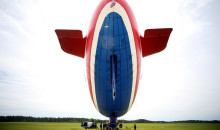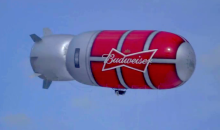Atlant Rising: Russia Fights to Lead Airship Revival
The eerie sensation of seeing something the size of a house floating in the air is something that no photograph can capture.
That was the sight witnessed from the ground when the 55-meter-long AU-30 blimp, built by Russian company Augur RosAeroSystems, soared away from the country’s sole, recently reopened “dirigibledrome” in Russia’s central Vladimir Region for a 100-kilometer journey to Russia’s prime airshow, MAKS.
But the AU-30, with its maximum payload of half a ton, is itself about to be dwarfed by Augur’s next project: the Atlant, which will be able to carry 16 tons of cargo through the air – provided the project gets off the ground.
Six decades after the German passenger airship the Hindenburg burst into flames and plunged to the ground in a matter of seconds in 1937, putting a fiery end to the golden age of the dirigible, the airship industry slowly willed itself back into existence over the 2000s. It was a process driven to a considerable extent by Soviet-educated enthusiasts on both sides of the Atlantic.
Airships are cheaper to fly than helicopters and airplanes, can carry more cargo than heavier-than-air flying vehicles and are capable of reaching remote and hard-to-reach areas such as the far north, proponents say. A Hindenburg-style explosion is no longer a risk, because modern airships fly on inert helium rather than flammable hydrogen.
Nevertheless, for the time being, mammoth cargo airships mostly remain at the drawing board stage. Critics say big airships struggle with lift control problems, which also requires costly infrastructure, including hangars.
“Maybe customers just don’t need big airships,” said Roman Gusarov, editor-in-chief of aviation news website Avia.ru. But at Augur – one of the world’s leaders in the admittedly tiny field of lighter-than-air aircraft making – they are sure the world needs more cargo airships.
Eye in the Sky
The nominal purpose of Augur’s blimps is aerial photography and technical monitoring, though at least one was bought by a Thai company for advertising purposes, Goodyear Blimp-style, Augur vice president Mikhail Talesnikov said in an interview with RIA Novosti.
He estimated the world’s entire dirigible fleet at about 50 vehicles, with one in five produced by Augur, a private company established in 1991 that carved a niche for itself making airships and unmanned tethered balloons. The latter are increasingly used for surveillance purposes, both civilian (such as monitoring traffic) and military, he said. Two such aircraft made by the US company TCOM can be seen in the sky over Kabul, watching the approaches to the city airport for signs of the Taliban.
One of 12 blimps that Augur has sold since 2005 was meant to fly to the North Pole.
“A group of French explorers bought it. But they mishandled it, and now it’s inoperable,” Alexei Arkhipov, deputy director of the “dirigibledrome” in the town of Kirzhach, said in an interview under the belly of a parked AU-30.
At the MAKS airshow in the city of Zhukovsky, the AU-30 performed daily two-hour flights, showcasing its traffic monitoring capabilities, though not taking on board any passengers due to “paperwork problems”, according to Augur spokesman, Alexei Mitrofanov.
Flying Freighters
But what every blimp maker in the world dreams about is cargo airships – and they have their reasons.
The cost of flying an airship is $150-$200 per hour, compared to $1,500-$4,000 for helicopters, Sergei Bendin of the Russian Aeronautical Society said in an article on Cnews.ru in 2009.
Admittedly, an airship is only handy when speed is not a priority: The AU-30’s cruise speed is only 80 kph (50 mph). But the floating airships can stay in the air much longer than heavier-than-air aircraft.
Then there is the price: The Atlant will cost 30 percent less than a Mi-26 heavy transport helicopter, Talesnikov said. The price range for a Mi-26 is $20 million to $25 million, though it can carry four more tons of cargo than Augur’s prospective airship.
The Atlant, whose maiden flight is tentatively expected in 2017 or 2018, could trigger a new era for petroleum companies, which will be able to access oil and gas fields in Siberia and the Arctic whose exploration is currently unprofitable because of the exorbitant costs of building road and pipeline infrastructure, Talesnikov said.
While cargo transport may be the most lucrative potential held by airships, it is far from the only possible use. Passenger transportation could become significantly less of a headache for remote localities in Siberia, Alaska and northern Canada with the introduction of airships, Robert Knotts of the international Airship Association, a London-based non-profit group, said in emailed comments.
The military is also interested in having a cheap means of hauling troops and equipment over long distances. Augur’s main counterpart in the United States, the California-based Aeros, has been tapping into grants from the Defense Advanced Research Projects Agency (DARPA) since 2005.
What’s the Catch?
Russian border guards considered getting an AU-30 for their detachments fighting drug trafficking along the long and porous Kazakh border in Central Asia, Talesnikov said.
Traffickers move at night, invisible and untraceable, but a jet black blimp with an infrared camera and a platoon of soldiers on board could sweep down on them like an owl on an unsuspecting mouse – if only it could actually unload the troops without vanishing into the sky due to changed buoyancy.
Loading and unloading is a fundamental issue for airships, whose flying characteristics are heavily influenced by their weight and changes in it, Augur’s Arkhipov said.
Dirigibles of the Hindenburg generation had to pump tons of water or sand into the ballast tanks when unloading passengers, which required complicated infrastructure – as did the mooring and parking.
The operability of modern blimps is also limited by wind force. The AU-30 cannot fly in winds with a speed of over 12 m/s – a force six wind on the 12-degree Beaufort scale, and just a breeze by Siberian standards.
Dirigibles may be cheaper to fly, but not to maintain, given the costs of mooring masts and the hangars they need to be sheltered in during strong winds, said Alexei Sinitsky, editor-in-chief of the Aviatransportnoye Obozrenie (Air Transport Observer) trade magazine.
“The enthusiasm of airship aficionados can be understood, but there are all kinds of boring unromantic issues involved,” Sinitsky said.
A New Generation
However, airship makers claim to have solutions for all the problems.
The main breakthrough was the development of a new ballast system, in which air-filled ballonets are placed inside the airship’s helium-filled outer envelope, said Talesnikov.
The system eliminates the need for water or sand-based ballast, and makes it possible to unload and park simply by operating the air pump handles, he said. The technology was developed independently by both Augur and the US Aeros, and is implemented in the AU-30 and the American company’s Aeroscraft machine, whose scaled-down unmanned prototype was unveiled last year.
New generation airships are also partly reliant on engines and aerodynamic shape for lift, which improves maneuverability, said Knotts of the Airship Association.
Aircraft developers struggle to raise funds for research and development, Sinitsky said. But Talesnikov claimed that Augur – a resident of Russia’s hi-tech hub Skolkovo – is already getting options for the Atlant from oil companies and Siberian regional authorities. He gave no figures for the options, but said R&D costs for the aircraft will be between $55 million and $70 million.
A Phoenix From the Ashes
The first “dirigible” – powered by steam – took to the skies over France in 1852, but the golden age of the airship was the first decades of the 20th century, when Count Zeppelin developed rigid airships (a constructive step up from blimps, which have no rigid carcass) powered by combustion engines.
But even at the time, no cargo airships were made – and in terms of passenger transportation and military use, the slow and hazardous hydrogen-filled airships could not compete with the rapidly developing heavier-than-air aviation.
Airships fell out of use following World War II, surviving mostly in popular culture, from the name of the rock band Led Zeppelin to the gigantic propelled lighter-than-air machines featured in the “steampunk” genre of science fiction, such as the creations of Oscar-winning Japanese animator Hayao Miyazaki.
However, in the 1990s, Germany’s resurrected Zeppelin company funded the production of the semi-rigid airship Zeppelin NT.
The project was driven more by nostalgia than desire for profit, Talesnikov said. But more companies followed, including the British Hybrid Air Vehicles, as well as the US firms Lockheed Martin and Boeing, both of which designed airships, though never built them.
A Childhood Passion
Russia’s Augur was established in 1991 and premiered its first airship, the AU-11, in 2005; the US Aeros was created in 1993. Curiously enough, both companies’ CEOs – Gennady Verba and Igor Pasternak, respectively – were schoolmates in the Ukrainian city of Lvov who developed a passion for airships back in middle school and went on to pursue their dream on different sides of the Atlantic, Talesnikov said.
“I wasn’t an enthusiast at first; Verba simply invited me to join them 13 years ago, when they were just getting into airships,” said Talesnikov, who also went to the same school as Verba and Pasternak.
“And I got hooked,” he said with an apologetic laugh, before launching into a tantalizing explanation of what flying in an airship feels like.
via – RIA Novosti.





